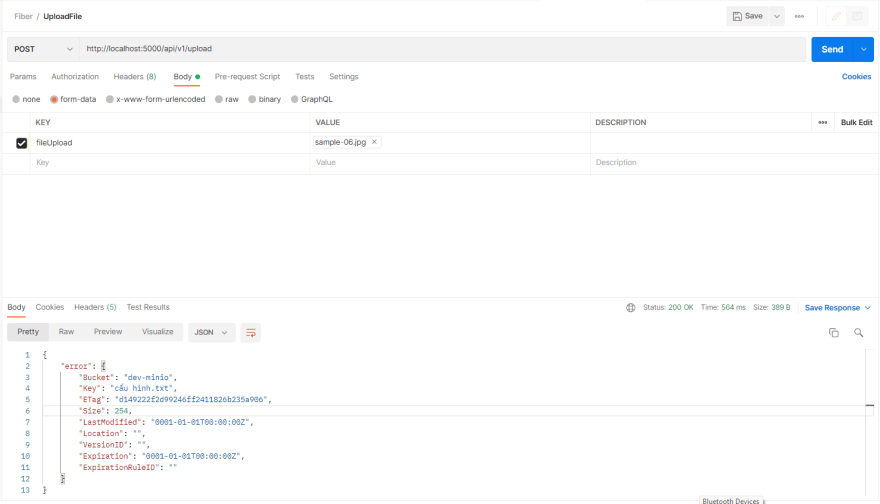Introduction
Hello, friends! 😉 Welcome to a really great tutorial. I've tried to make for you as simple step-by-step instructions as possible, based on a real-life application, so that you can apply this knowledge here and now.
I'm writing this tutorial only to share my experience and to show that backend development in Golang using the Fiber framework is easy!
What do we want to build?
Let's create a REST API with fiber which we upload file into Minio.
Setting Minio with Docker
Install and run Docker service for your OS. By the way, in this tutorial I'm using the latest version (at this moment) v20.10.10
docker run \
-p 9000:9000 \
-p 9001:9001 \
--name minio1 \
-v D:\data:/data \
-e "MINIO_ROOT_USER=AKIAIOSFODNN7EXAMPLE" \
-e "MINIO_ROOT_PASSWORD=wJalrXUtnFEMI/K7MDENG/bPxRfiCYEXAMPLEKEY" \
quay.io/minio/minio server /data --console-address ":9001"
☝️ For more information, please visit: https://docs.min.io/docs/minio-docker-quickstart-guide.html
Fiber config in ENV file
# Minio settings:
MINIO_ENDPOINT="localhost:9000"
MINIO_PORT= 9000
MINIO_ACCESSKEY="AKIAIOSFODNN7EXAMPLE"
MINIO_SECRETKEY="wJalrXUtnFEMI/K7MDENG/bPxRfiCYEXAMPLEKEY"
MINIO_BUCKET="dev-minio"
Minio connection
The minio connection is the most important part of this application.
- The method for the connection:
// ./platform/minio/minio.go
package minioUpload
import (
"context"
"log"
"os"
"github.com/minio/minio-go/v7"
"github.com/minio/minio-go/v7/pkg/credentials"
)
// MinioConnection func for opening minio connection.
func MinioConnection() (*minio.Client, error) {
ctx := context.Background()
endpoint := os.Getenv("MINIO_ENDPOINT")
accessKeyID := os.Getenv("MINIO_ACCESSKEY")
secretAccessKey := os.Getenv("MINIO_SECRETKEY")
useSSL := false
// Initialize minio client object.
minioClient, errInit := minio.New(endpoint, &minio.Options{
Creds: credentials.NewStaticV4(accessKeyID, secretAccessKey, ""),
Secure: useSSL,
})
if errInit != nil {
log.Fatalln(errInit)
}
// Make a new bucket called dev-minio.
bucketName := os.Getenv("MINIO_BUCKET")
location := "us-east-1"
err := minioClient.MakeBucket(ctx, bucketName, minio.MakeBucketOptions{Region: location})
if err != nil {
// Check to see if we already own this bucket (which happens if you run this twice)
exists, errBucketExists := minioClient.BucketExists(ctx, bucketName)
if errBucketExists == nil && exists {
log.Printf("We already own %s\n", bucketName)
} else {
log.Fatalln(err)
}
} else {
log.Printf("Successfully created %s\n", bucketName)
}
return minioClient, errInit
}
Create controllers
The principle of the POST methods:
- Make a request to the API endpoint;
- Parse Form File of request (or an error);
- Make a connection to the minio (or an error);
- Validate file with a new file from Form-data (or an error);
- Upload a new record in the table books (or an error);
- Return the status 200 and JSON with a new info file;
// ./app/controllers.upload_controller.go
package controllers
import (
"context"
"log"
"os"
"github.com/gofiber/fiber/v2"
minioUpload "github.com/minhblues/api/platform/minio"
"github.com/minio/minio-go/v7"
)
func UploadFile(c *fiber.Ctx) error {
ctx := context.Background()
bucketName := os.Getenv("MINIO_BUCKET")
file, err := c.FormFile("fileUpload")
if err != nil {
return c.Status(fiber.StatusBadRequest).JSON(fiber.Map{
"error": true,
"msg": err.Error(),
})
}
// Get Buffer from file
buffer, err := file.Open()
if err != nil {
return c.Status(fiber.StatusBadRequest).JSON(fiber.Map{
"error": true,
"msg": err.Error(),
})
}
defer buffer.Close()
// Create minio connection.
minioClient, err := minioUpload.MinioConnection()
if err != nil {
// Return status 500 and minio connection error.
return c.Status(fiber.StatusInternalServerError).JSON(fiber.Map{
"error": true,
"msg": err.Error(),
})
}
objectName := file.Filename
fileBuffer := buffer
contentType := file.Header["Content-Type"][0]
fileSize := file.Size
// Upload the zip file with PutObject
info, err := minioClient.PutObject(ctx, bucketName, objectName, fileBuffer, fileSize, minio.PutObjectOptions{ContentType: contentType})
if err != nil {
return c.Status(fiber.StatusInternalServerError).JSON(fiber.Map{
"error": true,
"msg": err.Error(),
})
}
log.Printf("Successfully uploaded %s of size %d\n", objectName, info.Size)
return c.JSON(fiber.Map{
"error": false,
"msg": nil,
"info": info,
})
}
Routes for the API endpoints
// ./pkg/routes/not_found_route.go
package routes
import (
"github.com/gofiber/fiber/v2"
"github.com/minhblues/api/app/controllers"
)
// PublicRoutes func for describe group of public routes.
func PublicRoutes(a *fiber.App) {
// Create routes group.
route := a.Group("/api/v1")
// upload files
route.Post("/upload", controllers.UploadFile)
}
The main function
package main
import (
"github.com/gofiber/fiber/v2"
_ "github.com/joho/godotenv/autoload" // load .env file automatically
"github.com/minhblues/api/pkg/configs"
"github.com/minhblues/api/pkg/routes"
"github.com/minhblues/api/pkg/utils"
)
func main() {
// Define Fiber config.
config := configs.FiberConfig()
// Define a new Fiber app with config.
app := fiber.New(config)
routes.PublicRoutes(app) // Register a public routes for app.
// Start server (with graceful shutdown).
utils.StartServer(app)
}
Run project
Some people (including me) crave live reloading in Go, especially the ones who are used to working with interpreted languages like JavaScript, Python, and Ruby. This project I will use nodemon.
☝️ For more ways, please visit: https://techinscribed.com/5-ways-to-live-reloading-go-applications/
nodemon --exec go run main.go --signal SIGNTERM
Test upload file
http://localhost:9001/dashboard:
username: AKIAIOSFODNN7EXAMPLE
password: wJalrXUtnFEMI/K7MDENG/bPxRfiCYEXAMPLEKEY
Postman
http://localhost:5000/api/v1/upload:
Result Minio
http://localhost:9001/buckets/dev-minio/browse:
It works. Woohoo! 🎉
P.S.
If you want more articles like this on this blog, then post a comment below and subscribe to me. Thanks! 😘









Latest comments (1)
link to the repo please..?